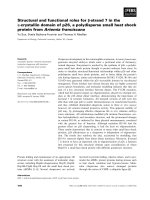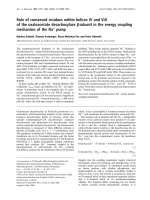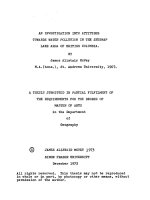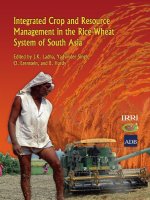James albert young, b abbott sparks cattle in the cold desert university of nevada press (2002)
Bạn đang xem bản rút gọn của tài liệu. Xem và tải ngay bản đầy đủ của tài liệu tại đây (5.07 MB, 334 trang )
Cattle in the Cold Desert
James A. Young and B. Abbott Sparks
U N I V E R S I T Y O F N E VA D A P R E S S / R E N O & L A S V E G A S
www.pdfgrip.com
www.pdfgrip.com
Cattle in the Cold Desert
James A. Young and B. Abbott Sparks
U N I V E R S I T Y O F N E VA D A P R E S S / R E N O & L A S V E G A S
www.pdfgrip.com
Cattle in the Cold Desert was originally published by Utah State University
Press in 1985.
University of Nevada Press, Reno, Nevada 89557 usa
New material copyright © 2002 by University of Nevada Press
All rights reserved
Manufactured in the United States of America
Design by Carrie House
Library of Congress Cataloging-in-Publication Data
Young, James A. (James Albert), 1937 –
Cattle in the cold desert / James A. Young and B. Abbott Sparks.
p. cm.
Originally published: Logan, Utah : Utah State University Press, © 1985.
isbn 0-87417-503-8 (pbk. : alk. paper)
1. Beef cattle—Great Basin—History—19th century. 2. Ranchers—Great
Basin—History—19th century. 3. Ranchers—Great Basin—Biography. 4.
Ranch life—Great Basin—History—19th century. 5. Range ecology—Great
Basin—History—19th century. 6. Sparks, John, 1843–1908. 7. Harrell,
Jasper, 1830–1901. 8. Grazing—Environmental aspects—Great Basin—
History—19th century. 9. Great Basin—History—19th century. I. Sparks,
B. Abbott, 1919– . II. Title.
sf196.u5y68 2002
636.2'00979—dc21 2002008742
The paper used in this book meets the requirements of American
National Standard for Information Sciences—Permanence of Paper for
Printed Library Materials, ansi z39.48-1984. Binding materials were
selected for strength and durability.
11 10 09 08 07 06 05 04 03 02
5 4 3 2 1
www.pdfgrip.com
To the Memory of John Sparks, Cattleman, and
to those who followed on to the New Lands
www.pdfgrip.com
www.pdfgrip.com
contents
List of Illustrations, viii
Acknowledgments, ix
Introduction, xi
Prologue: Five Days in August, 1
Part I The Open Land
1. Gray Ocean of Sagebrush, 19
2. The Exploitation Pageant, 37
3. Left-Hand Trail to Hell, 57
4. Texas Cattle and Cattlemen, 70
Part II The Land Acquired
5. Buy, Beg, Borrow, or Steal a Ranch, 89
6. John Sparks: Capital, Credit, and Courage, 101
7. White Winter: White Hills of Bones, 119
8. Water: The Finite Resource, 137
Part III The Land in Transition
9. Making Hay in the Great Basin, 155
10. From Dugouts to Cattle Empires, 180
11. Herefords in the Sagebrush, 194
12. Horses, Tame and Wild in the Sagebrush, 212
Part IV The Land Answers
13. The Passing of the Old Guard, 237
Epilogue, 257
Notes, 271
Equivalency Name Table, 303
Index, 307
www.pdfgrip.com
illustrations
p h ot o g r a p h s
Open range, 16–17
Cattle on playa, 86–87
Early haying, 152–153
John Sparks, 234–235
figures
Figure 1. Boundary of the Great Basin, xiii
Figure 2. Sagebrush communities distributed on alluvial fans, 26
www.pdfgrip.com
acknowledgments
I greatly appreciate the many hours Glenda Eskstrom and Jamie Peer
spent typing the many drafts of this manuscript. Appreciation is also
expressed to Guy Rocha, Nevada State Archivist, and Phil Earl, Nevada
Historical Society, who were always ready to help track down details and
sources. The interlibrary loan staV of the Life and Health Sciences and
Getchell Libraries, University of Nevada, spent many hours obtaining
material used in this manuscript. I am equally appreciative of the many
other librarians and individuals who provided answers to my numerous
requests.
Several individuals with the Agricultural Research Service of the U.S.
Department of Agriculture encouraged and prompted the development
of this manuscript. They include Dr. Raymond A. Evans, Research
Leader; Dr. Edward B. Knipling, former Area Director; and Dr. Peter H.
Van Schaik, former Associate Area Director. Howard Sherman contributed both his encouragement and his skill as an editor to this project.
Newton and Andy Harrell of Twin Falls, Idaho, provided a valuable
link between the present and such past historical characters as Henry
Harris. The Wrsthand accounts of these two cowboys sparkle with the
Xavor and color of the glory days of the Sparks-Harrell ranching empire.
I am very grateful to Dr. Charles S. Peterson, Utah State University,
for believing in the potential contribution of Cattle in the Cold Desert to
western history. Special thanks to Alexa West and Linda Speth, Utah State
University Press, for taking a chance on a diVerent kind of history manuscript.
Most of all, I thank my wife, Cheryl, and my children, Theresa, Patrick,
and Nancy Yini, for their patience and understanding.
James A. Young
I wish to express my sincere appreciation to Jim Young for his invitation
to join him in this work, which he conceived and researched throughout
www.pdfgrip.com
x
Acknowledgments
his eminent background. He and his many associates in Nevada, and the
intermountain ranching states, were a pleasure to work with.
My invaluable executive assistant over the last 47 years, Leta Lassetter,
devoted over a year to the compilation of background data, copy and editing to assist in the development of this manuscript. Don Fickert and Laura
Jacobus made signiWcant contributions to graphics and copyediting.
Russell E. Bidlack, editor of the Sparks Quarterly; Mrs. Grey Golden,
former Texas State Archivist; and Mary Sparks Matthews, editor and publisher of Fourteen Frontier Families, added valuable inputs as did Leland
Sparks of San Francisco, California, and Nancy Sparks Lawrence of Twin
Falls, Idaho.
The Matthews book, Fourteen Frontier Families, traces the Sparks and
related families through three hundred years of their pioneering progress
through eleven states following their arrival on this continent in 1660 as
forefather generations to brothers John and Tom Sparks.
Other Sparks family background was contributed by B. Abbott Sparks
Sr. and Van J. Sparks of Pauls Valley, Oklahoma (both great-nephews of
John Sparks), as well as Estha Scoggins of Georgetown, Texas.
The many personal contributions to the completion of this work were
inspiring and indispensable. I join Dr. Young in his tribute to Dr. Charles
Peterson, and add my special appreciation to the endeavors of Sandy
Crooms and her staV at the University of Nevada Press in bringing to life
this third printing (expanded edition) of Cattle in the Cold Desert.
Newton and Lida Harrell, formerly of Twin Falls, Idaho, provided a living link with historical characters in the book. Newton, a graduate of the
University of Oregon, who spent his life “cowboying,” was a live-wire
link to activities in the heydays of the Sparks/Harrell ranching empire.
Phil Earl and Guy Rocha were of invaluable assistance in obtaining and
making available much of the material and photographs used in this
manuscript.
B . A b b ot t S pa r k s
www.pdfgrip.com
introduction
On Cattle and Cold Deserts
All things occur within a larger context. Behind the individual events or
circumstances is the grand mosaic of surrounding events—the geologic
history, the human history, the environment.
Thus, around the people and land of the Great Basin there is a hint, a
Xavor, of events that have greater signiWcance when taken as a whole
rather than as individual occurrences or circumstances. Against the
backdrop of the cold desert’s sagebrush/grasslands is the pageant of
man and his herds. It is easy from a twentieth-century perspective to try
to discern the underlying “meaning of things,” in both a scientiWc and
a historical sense, but recognizing those speciWc events as meaningful
when they were under way would have taxed anyone’s intuition and intellect. Thus, it is doubtful that the early pioneers, ranchers, and sheep
men realized the signiWcance of events as they were actually happening.
This diYculty is perfectly understandable; even today we have no perspective when events are actually happening—when their place in the
larger context has not yet become clear.
However, as we try to point out in this book, if we are attentive we can
begin to gain a very useful sense of the larger context even while the
www.pdfgrip.com
xii
Introduction
events are in progress. We can do this by sensitizing our awareness to
fragments of history and science that we frequently ignore. These fragments are like puzzle pieces that, when recognized and assembled, give
an understanding of the greater meaning of things, the larger context.
Thus, we have taken the disciplines of science and history with their
individual events and circumstances, placed them in a speciWc place for
a speciWc time, and woven them together to create a larger view of the
Great Basin. The chapters alternate between land and man, but in a sense
they are inseparable, and that is the main thrust of this volume—the
larger picture of man and his cattle in the cold desert.
Another purpose of this volume is to provide perspective on the
inXuence of grazing animals on the ecology of the sagebrush/grasslands.
The scope of our coverage is designed to provide background information for those who earn their livelihood from grazing animals on sagebrush/grasslands, for professionals who manage such lands, and for
individuals living in or outside the sagebrush/grasslands environment
interested in the quality of life in this ecosystem.
This volume traces the history of man and his herds and Xocks of
domestic animals as they exploited the forage resources of a pristine
environment. We do not tell the entire story—only the introduction and
expansion period from roughly 1860 through the end of the nineteenth
century. Essentially, this volume consists of a discussion of scientiWc
principles and philosophies set in the context of historical events. It is
not meant to be a biography of principal characters such as John Sparks
and Jasper Harrell; however, it uses the life experiences of these and
other pioneers to illustrate how man, the herdsman, interacted with the
sagebrush/grasslands environment.
The story of the exploitation of the grazing resources of the sagebrush/grasslands recapitulates what has happened over virtually the
entire surface of the earth except for the bleakest Arctic wastes and
densest tropical jungles. The diVerence is that the sagebrush/grasslands
was one of the last great vegetation resources to be suddenly, radically,
www.pdfgrip.com
Introduction
Figure 1. Boundary of the Great Basin. From I. C. Russell, Geological History of Lake
Lahontan (U.S. Geological Survey, 1885).
www.pdfgrip.com
xiii
xiv
Introduction
and irrevocably changed by the introduction of domestic livestock. Because it is a relatively recent event, the process of the development of the
livestock industry in the sagebrush/grasslands can be reconstructed
with relative clarity.
Environmental quality is very much in the eyes of the beholder. A
major objective of this account is to provide perspective for decisions
on the nature of environmental quality in the sagebrush/grasslands. It
is diYcult for one to witness the degradation of one’s own homeland,
especially if the natural rate of environmental change is nearly static.
Environmental changes in the sagebrush/grasslands tend to reXect sudden catastrophic events followed by long struggles toward equilibrium.
To provide the reader with a sense of urgency regarding such catastrophic environmental events, we introduce this volume with a prologue, an account of Wve violent days in August 1964. The events it describes occurred after the time period (1860–1900) on which we
concentrate, but they were so dramatic that for a brief instant, a portion
of the general public questioned environmental quality in the sagebrush/grasslands and related it to human actions such as the introduction of large numbers of domestic cattle almost a century earlier.
Halfway through this volume we relate another environmental catastrophe—the hard winter of 1889–90. Both disasters forced herdsmen,
and the general public as well, to look at the consequences of their actions. For the general public, unfortunately, such perceptions are usually Xeeting and easily lost in the haze of pseudostability that seems to
follow sagebrush catastrophes.
The vegetation of the pristine sagebrush/grasslands was rather simple
and thus extremely susceptible to disturbance. The potential of the environment to support plant and animal life was limited by lack of moisture and often by accumulations of salts in the soil. The native vegetation lacked the resilience, depth, and plasticity to cope with
concentrations of large herbivores. When faced with grazing herds of
cattle, the plant communities did not adapt; they shattered. This fact
www.pdfgrip.com
Introduction
xv
tends to make a review of grazing in the sagebrush/grasslands a horror
story, a compilation of examples of what should not have been done. In
perspective, the development of ranching in the sagebrush/grasslands
was a grand experiment initiated by men willing to venture beyond the
limits of accepted environmental potential to settle the Great Sandy
Desert between the Rocky, Sierra Nevada, and Cascade Mountains.
The dynamics initiated by the introduction of domestic livestock into
the sagebrush/grasslands are still under way. Each plant community that
composes an eVective environment or habitat type in the sagebrush/
grasslands is a biological measure of the interacting factors that make
up the environment. The plant communities also mirror a century of
disturbance. Interpretation of the inXuence of history on potential is
essential to developing management schemes for the environment.
There are no more pristine sagebrush/grasslands to exploit. We must
learn to constructively use and restore the existing resource or sink into
an endless spiral of further degradation.
www.pdfgrip.com
www.pdfgrip.com
Gray Ocean of Sagebrush
1
prologue
Five Days in August
At 10 a.m. on the Saturday morning of August 15, 1964, Elko, Nevada, was
enjoying a pleasant summer morning with a few cumulus clouds drifting lazily east toward the towering bulk of the Ruby Mountains. The Ruby
Mountains still supported patches of snow in sheltered, north-facing
glacial cirques. Elko was hot and dry. Tourists felt sure they were going
to die while driving across the baking Nevada desert. Highway 40, the
major transcontinental route, passed through Elko and followed the
Humboldt River valley southwest to the sink where the river terminated
near the Carson Desert.
This was the pioneers’ route in the great rush to California in the
1850s.1 Modern travelers welcomed the comfortable motels and hotels
of Elko after the heat of the desert. The electric excitement of the casino
made them forget the endless sagebrush valleys and mountains. Liquor
was cheap and the Elko nightlife was out of proportion to the size of the
town, a transportation and supply center for the surrounding livestock
ranches. Divided by two sets of transcontinental railway tracks, Elko
County was advertised as the leading range livestock county in the nation. Some of the houses on the east side of the tracks had red lights over
www.pdfgrip.com
2
The Open Land
Prologue
their doors and cross-country diesel tractors and semi-trailers parked
in front with the motors idling. When the nightlife quieted down in the
early morning, the exhausted tourists dropped into bed, only to be
bounced right back out by the vibrations of a long freight train
highballing through town.
Elko was a western town—a town with a cowboy heritage. The doctor,
banker, barber, and undertaker dressed in western-cut suits or Levis and
high-heeled cowboy boots. The restaurants and casinos were decorated
in plush western motifs.
The lifestyle of Elko County ranchers had improved greatly since the
end of World War II. Beef and wool enjoyed a seller’s market after price
controls were lifted. According to an article in Life magazine, the only
thing in short supply in Elko in the late 1940s was one-hundred-dollar
bills.2 Many of the old ranchers sold to outside investors after the war.
Bing Crosby bought a ranch on the North Fork, and Jimmy Stewart
bought the old H-D Ranch on Thousand Springs Creek when the giant
Utah Construction Company was sold. The H-D was the jewel in John
Sparks’s nineteenth-century ranching empire. Ranches became popular tax shelters for the new rich in the postwar era. Cattle prices remained
relatively low during the early sixties, and very few ranchers were making a valid return on their capital investment.
As that August Saturday progressed, the Weather Bureau alerted the
local Wre-suppression agencies—the U.S. Forest Service (usfs) of the
U.S. Department of Agriculture (usda), the Bureau of Land Management
(blm) of the U.S. Department of the Interior (usdi), and the Nevada Division of Forestry (ndf)—of a 40 percent chance of thunderstorms.3 The
blm had the most land to worry about; 67 percent of the land area of Nevada was under its control.
Bob Carroll, the blm Wre control oYcer in the Elko District OYce, was
worried. He had recently been successful in getting his Wre crew increased from seventeen to twenty-seven men. He had started the summer with no standby Wre crew. On June 27, three days after Carroll Wnally
www.pdfgrip.com
Gray Ocean of Sagebrush
Prologue 3
got his standby crew, they had their Wrst Wre. His Wre crew was a collection of boys just out of high school, college students, and a few Indians
from Duck Valley and the South Fork of the Humboldt. What they lacked
in experience they made up in enthusiasm. They soon got experience,
too. By late July they had fought seventy-eight Wres, equal to the total
number of wildWres for 1963, and double the number for some previous
years.
Range managers had realized for thirty years that much of the lowerelevation sagebrush/grasslands were severely overgrazed. There were
millions of sagebrush-dominated acres with virtually no herbaceous
understory. The previous summer a blm oYcial from the Nevada headquarters in Reno had told a usda range scientist that these vast acreages
of degraded sagebrush range were an asset rather than a liability, an environment frozen in time. They were Wreproof because they lacked herbaceous vegetation to carry Wre. The blm developed plans and obtained
funds to selectively transform these degraded communities into grasslands by plowing them and seeding exotic (i.e., deliberately introduced)
perennial crested wheatgrasses.4
The spring of 1964 had been prolonged and wet. The alien (i.e., accidentally introduced) weed cheatgrass responded to the late spring moisture by producing a tremendous crop of herbage. On the northwest side
of Emigrant Pass in July 1964, range scientists clipped four thousand
pounds of cheatgrass per acre from experimental plots. On normal years
cheatgrass often produces only a few hundred pounds of herbage per
acre, and on dry years virtually nothing. Cheatgrass is an annual that
dries in early summer and provides a Wnely textured Xash fuel that carries wildWre through sagebrush stands. The nine large Wres that occurred
during July showed the extent to which this accumulation of cheatgrass
constituted a Wre hazard. One of those Wres burned forty-Wve thousand
acres.
From August 1 to August 15 there were lightning storms somewhere
in Nevada nearly every day. On July 29 there were Xash Xoods at Yering-
www.pdfgrip.com
4
The Open Land
Prologue
ton, Nevada, that tumbled cars around on the highway like rubber toys.
On August 11 Tonopah, Nevada, had a similar storm. Elko expected at
least one intense lightning storm each year. The Wre-suppression
oYcials could only hope that the lightning storm and peak Wre conditions
did not coincide.
Bob Carroll waited and worried. His boss, Clair Whitlock, the Elko blm
district manager, had left on vacation the night before, and Bob had the
lonely feeling that he was sitting on a powder keg with a lit fuse. He
checked the light plane he planned to Xy for spotting lightning strikes
and talked to the two Torpedo Bomber-Medium (tbm) pilots the blm had
on contract at the Elko airport. These pilots Xew aging World War II navy
bombers modiWed for dumping a slurry of bentonite (a form of clay) on
Wres. Pilots had to love Xying and danger to be involved in this business.
Some years there were no Wres and they spent a lot of time waiting around
hot airports, tinkering with worn-out airplanes. If the pilot was lucky,
some Wre agency paid him a standby fee.
The standby Wre crew in Elko viewed the 40 percent prospect of lightning with mixed emotions. The pumpers were serviced and the bulldozers were loaded on the lowboy trailers and ready to go. The summer Wrecrew members welcomed Wres because they brought relief from boredom
and petty jobs around the blm yards. Most of all, Wres meant overtime and
extra dollars. On the other hand, it was Saturday night, and the pleasures
of Elko were awaiting their youthful enthusiasm. Working hard and playing hard were equal parts of being on Wre crews.
There had been so many Wres during July that the professional range
managers in the blm had been forced to drop their regular jobs administering grazing on the national resource lands to concentrate on Wre
suppression. Fire was a physical thing that could be attacked and defeated
through hard work and planning. Good land management was a nebulous thing with shifting goals, endless red tape, and insuYcient funds
that provoked anything from apathy to outright hostility from ranchers.
Neither Bob Carroll nor the pilots and standby crews knew it, but their
www.pdfgrip.com
Gray Ocean of Sagebrush
Prologue 5
fate was sealed by 10 a.m. that Saturday morning. An upper-level lowpressure system moved across central California in the early morning, and
at 10 a.m. it was located south of Lake Tahoe over the Sierra Nevada.
At 1 p.m. there were towering cumulus and cumulonimbus clouds
across the northern Great Basin. Winnemucca, Nevada, reported lightning and a sprinkling of rain in the early afternoon. Teleprinters clattered to life in Weather Bureau oYces, and Wre radios crackled with the
ominous news that the cloud base was six thousand to nine thousand feet
high, indicating a lack of moisture in the clouds. From Winnemucca to
Wendover, Nevada, dry lightning cracked in sheets and massive single
bolts on the tinderbox rangelands. The dry lightning Xashed without
accompanying rain.
By late Saturday afternoon, about thirty-Wve Wres had been reported.
One experienced blm Wreman started for the Willow Creek Wre in a
pickup, and on the way put out an estimated three hundred acres of spot
Wres that no one had reported. The tbms Xew into the thunderstorms at
incredible risk and helped knock down sixteen of the Wres. The remaining Wres burned together to form the Boulder, Maggie Creek, Willow
Creek, Palisade, and New Corral Wre complex with the Upper Clover as a
single Wre. Someone coined the word “Wrestorm.” It Wt the situation and
it stuck.
Bob Carroll luckily reached the district manager, Clair Whitlock, at his
Wrst vacation stop. He told Clair he had to return to Elko; they had a
Wrestorm. As the district manager put the phone down to face his family
with the news that the vacation was aborted, he wondered what in the hell
a Wrestorm was.
Considering the enormous acreage burning, the suppression crew did
quite well on Sunday with the limited manpower and equipment available. Ranchers organized their own crews to Wght spot Wres and generally
cooperated with the government agencies in controlling the range Wres.
They were concerned about cattle in the Wre areas and worried that the
areas of dry forage they planned to graze that fall were being burned. The
www.pdfgrip.com
6
Prologue
The Open Land
citizens of Elko were less concerned. It was the peak of the tourist season, hay was being cut on the ranches, and construction projects were
in full swing. Anyone who wanted to work had a job, and no one was interested in helping the government Wght Wres. “Let it burn, it will improve the range,” was the oft-repeated comment in street-corner conversations.
Rancher Joe Peretti, of the 7 Lazy Y Ranch near Elko, was frantic about
his cattle. Normally cattle were quite capable of getting out of the way of
wildWres, but these animals had never experienced a Wrestorm on sagebrush rangelands. Lurid tales appeared in the Reno and Salt Lake papers
suggesting that hundreds or even thousands of cattle had been killed and
that the loss of fall forage would force early sales and cost millions in
losses.
It was a long, sleepless Saturday night for the blm personnel. Their
problem on Sunday was to Wnd bodies to press into Wre crews. The state
blm oYce in Reno responded quickly with help from other districts. The
Humboldt District took over the Kelly Creek Wre that was near their
boundary. The state director of the blm, J. Russell Penny, did not Wt the
stereotype of a successful bureaucrat. He was dynamic and could act decisively and organize eVectively, but the only men immediately available
from outside the bureau were winos oV Lake Street, which at that time
was the skid row of Reno. They volunteered quickly enough, but their
physical condition made them a safety hazard when they reached the Wre
lines.
By Sunday night, August 16, outside Wre crews and overhead personnel were arriving in Elko and being dispatched. The overhead personnel
were supervisors present to take over the organization and direction of
Wre-suppression eVorts. This was supposed to give Bob Carroll a chance
for a few minutes’ rest, but he could not rest easily knowing there were
Weld crews who had worked twenty-four hours straight without rest or
food.
The Nevada Youth Training Center, a school for incorrigible boys
www.pdfgrip.com
Gray Ocean of Sagebrush
Prologue 7
committed by the courts, had dispatched its Wfty-man crew under ndf
foresters. During the 1930s and the days of the Civilian Conservation
Corps (ccc), it was discovered that tough kids could be molded into Wre
crews if they were given quality leadership, training, and esprit de corps.
The practice may have had no lasting reform inXuence on the boys, but
at the time, dispatchers referred to Wfty men from the Youth Training
Center.
The blm Wre boss at the Elko headquarters had accumulated a reserve
crew by midday on Monday. The crew had been fed and loaded on buses,
and was going out the gate of the blm yards when word was received of a
large new Wre near Elko. This was the Sherman Wre, and the buses were
diverted to attack the blaze. About one-half hour later the Grindstone Wre
was reported. Clair Whitlock would later comment that the Sherman and
Grindstone Wres broke the back of the Wre-suppression program. Not
only did these two new sleeper Wres exhaust all his reserves, but the conditions that caused them to explode spelled disaster. The temperature
was rising, the humidity was dropping, and the afternoon winds were
increasing.
The Wre-Wghting air force had been greatly augmented by Monday.
The Wre dispatcher allotted seven tankers to hit the Sherman Wre when
it was Wrst reported. The Wre was only seven miles from the airport, but
despite the advantage of a short ferrying distance, the planes could not
suppress it. The rate of its spread was beyond the experience of any of the
WreWghters; an estimated ten thousand acres burned in two hours.
As the sun went down Monday night, there was a glow west of Elko. The
particularly aromatic smell of sagebrush smoke was evident even in the
air-conditioned casinos. The attitude of the townspeople underwent a
sudden change. The blm was besieged with volunteers. An army of
WreWghters poured into Elko from throughout the West. Nevada State
Forester George Zappettini called on Governor Grant Sawyer for help.
The Nevada National Guard was called out to assist in Wre suppression,
crew feeding, and transportation. The Nevada Air National Guard took
www.pdfgrip.com
8
The Open Land
Prologue
aerial photographs of the burned area. Senators Howard Cannon and
Alan Bible called on Secretary of the Interior Stewart Udall, who promised to render all possible aid. Air Force bases Stead and Hill responded
with medical teams, transportation, and more bulldozers.
Communications problems haunted the WreWghters. The Boulder Wre
boss had Wfteen aerial tankers dropping slurry in crossing patterns, with
only one communications channel to direct all of them. There was not
enough radio equipment, and much of what was available failed to function. Crews left Elko with drivers who had only a vague idea about where
they were supposed to deliver the WreWghters. A cook on the Boulder Wre
asked the Wre boss to radio for six hundred rations for dinner; later he
raised it to one thousand, then two thousand.
WildWres in sagebrush vegetation normally explode during the late
afternoon and quiet down after sunset when the winds die down. On
Monday night, August 17, 1964, temperatures stayed relatively warm. The
humidity was low, and the dawn came with swirling winds. The Boulder
Wre camp had to be moved several times during the night as the winds
continually changed direction and rolled Xames over the camps.
Tuesday was the day of the air force. More than forty aircraft were involved, including lead planes, tankers, and reconnaissance planes. There
were twenty-one air tankers Xying at one time. In addition, there was a
large Xeet of charter and U.S. Air Force planes. The runway was too short
for the Air Force’s largest planes, but c-119 cargo planes were unloaded
as they rolled by without stopping. The Federal Aviation Administration
(faa) set up a special visual Xight rules control tower on top of the
airport’s terminal to handle the traYc. On Tuesday, August 18, Elko’s
airport handled more Xights than Los Angeles International. Something
relatively new in Wre Wghting was the use of Wfteen helicopters to transport crews to remote locations with speed and ease. Fire crews still remember their relief when a helicopter brought Wfteen gallons of badly
needed drinking water. The Wre air force became supertechnical when a
usfs research plane carrying infrared sensing equipment capable of
www.pdfgrip.com









